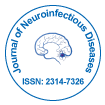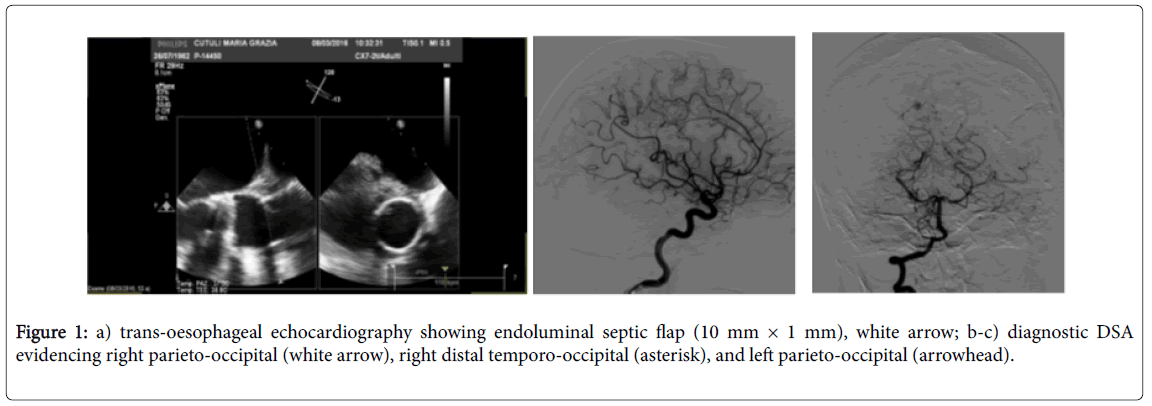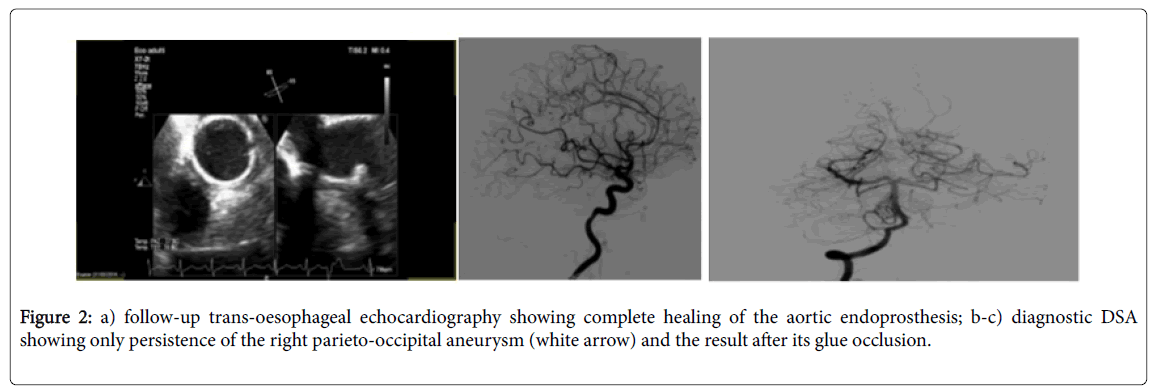Clinical images Open Access
Dynamic Nature of Cerebral Mycotic Aneurysms
Pietro Panni*
Department of Neurosurgery, Unversità Vita-Salute San Raffaele, Milan, Italy
- *Corresponding Author:
- Pietro Panni
Department of Neurosurgery
Unversità Vita-Salute San Raffaele
via Olgettina 60, Milan 20132, Italy
Tel: 00390226432396
Email: panni.pietro@hsr.it
Received Date: Apr 11, 2017 Accepted Date: Apr 13, 2017 Published Date: Apr 15, 2017
Citation: Panni P (2017) Dynamic Nature of Cerebral Mycotic Aneurysms. J Neuroinfect Dis 8: i001. doi:10.4172/2314-7326.1000i001
Copyright: © 2017 Panni P. This is an open-access article distributed under the terms of the Creative Commons Attribution License, which permits unrestricted use, distribution, and reproduction in any medium, provided the original author and source are credited
Visit for more related articles at Journal of Neuroinfectious Diseases
Abstract
A 53 years old female was admitted to our department in coma (GCS 5/15) after abrupt onset of headache. Plain CT scan showed left acute subdural hematoma which was emergently evacuated.
Clinical Image
A 53 years old female was admitted to our department in coma (GCS 5/15) after abrupt onset of headache. Plain CT scan showed left acute subdural hematoma which was emergently evacuated. The patient was assuming oral anticoagulants because of previous aortic valve replacement and aortic endoprosthesis positioning. After surgery, the patient gradually made a full recovery (GCS 15/15). During the subsequent hospital course, she developed right homonymous hemianopia followed by troubles of consciousness and septic status. Head CT scan displayed a left occipital hemorrhage. Blood cultures showed Streptococcus equisimilis infection and trans-oesophageal echocardiography disclosed septic involvement of endoprosthesis (Figure 1a).
Ampicillin 2 g 6 times/day was administered. Diagnostic digital subtraction angiography (DSA) evidenced three mycotic aneurysms (Figure 1b and 1c). Ceftriaxone 2 g twice daily was added in order to maximize the chances to obtain a response to antimicrobial therapy in the central nervous system. The patient gradually recovered to GCS 15/15. At the follow-up DSA two out of three of mycotic aneurysms were not more evident. The larger and still visible one was treated with endovascular glue occlusion (Figure 2b and 2c). Follow-up transoesophageal echocardiography revealed disappearance of the endoluminal infectious flap (Figure 2a).
This case exemplifies both the dynamic nature of mycotic aneurysms and the strength of antimicrobial tailored therapy. The disappearance of aneurism after DSA is mandatory to ascertain the complete recovery of the involved vessel. While aneurysm occlusion is advisable in cases of lesion patency.
--Relevant Topics
- Bacteria Induced Neuropathies
- Blood-brain barrier
- Brain Infection
- Cerebral Spinal Fluid
- Encephalitis
- Fungal Infection
- Infectious Disease in Children
- Neuro-HIV and Bacterial Infection
- Neuro-Infections Induced Autoimmune Disorders
- Neurocystercercosis
- Neurocysticercosis
- Neuroepidemiology
- Neuroinfectious Agents
- Neuroinflammation
- Neurosyphilis
- Neurotropic viruses
- Neurovirology
- Rare Infectious Disease
- Toxoplasmosis
- Viral Infection
Recommended Journals
Article Tools
Article Usage
- Total views: 2896
- [From(publication date):
June-2017 - Aug 09, 2025] - Breakdown by view type
- HTML page views : 2075
- PDF downloads : 821


